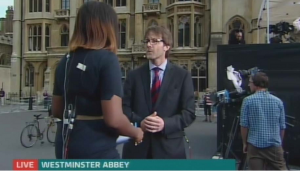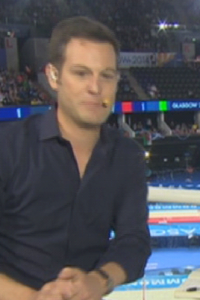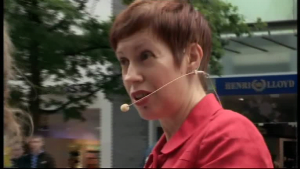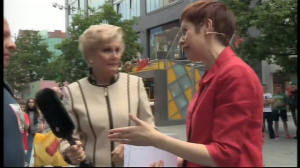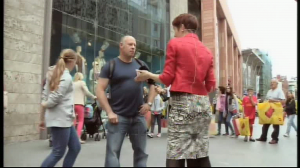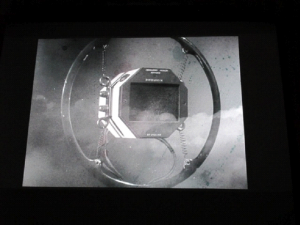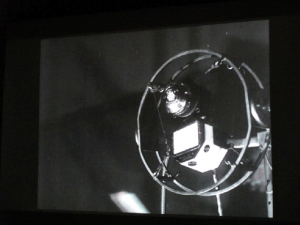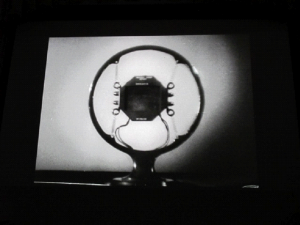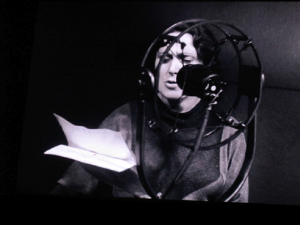John Howell (2)
I can’t remember ever seeing STC 4017s and 4035s on the Tech. Ops. booking sheet. Perhaps News or Post Production used them. What is a 4031? A 4032 is a handheld reverse Talkback mic first seen (by me) on Grandstand in Lime Grove G or E.
Jeff Booth
I don’t recall ever seeing a 4017 or 4035 in Post Production/VT. We had a couple of Coles Lip mics (for Sport Commentaries etc.) but that’s about all.
Tony Crake
We used lots of these weird 4035/21 etc as tee mics on golf courses. In the early 1980s they were "binned" and a 416 Sennheiser became the tee mic of choice ! A large improvement was universally noted !
Alasdair Laurance, Dave Plowman
I’m glad I’m not the only one who didn’t know what a 4031 is! Could it be a 4032 without the off/on switch?
John Howell (2)
I think Dave may be right, a 4032 without the Pressel switch, although STC tended to add letters for different versions. Eg a 4037C is a smaller version of the 4037A hand mic.
Albert Barber
Does anyone know of the Swedish (or is it Norwegian) Surround sound mic? I saw one the other day. Records 5 channels separately, L and R, and very neat.
Chris Woolf
I think you mean the Swedish Milab SRND360, which uses 3 physical capsules and generates 3 more virtual ones in between them using matricing techniques. You get 6 outputs spaced at 60° horizontally, and these can be further converted to any form of surround you like. It is a truly coincident system, related to, but not the same as, Sound-Field.
Dave Mundy
The British Calrec Sound-Field mic had 4 mic capsules arranged in a tetrahedron and outputted A and B-format signals which could be processed after the show (if necessary) to alter the polar diagram and effectively zoom in to a particular area. You could also adjust the polar diagram live so you could pan the pick-up angle round to cover a marching band, for instance (Ian Lieper, R.I.P., did so on a Royal Tournament in Earls Court). There were 6 such mics used by Radio OBs in St. Pauls, for Diana and Charles’s wedding, recorded onto a 24-track tape which was to be used for a Royal playback at Windsor. Unfortunately, someone high up in ROBs pressed the wrong button and erased some of the tape! Wikipedia has more information about the Calrec. Dummy head recordings were demonstrated at one of the IBS meetings and were very convincing especially one recorded in the central reservation in the Strand, where passing taxis really made you want to move out of the way!
Mike Jordan
An interesting bit in the BBC Royal Academy programme.
They showed a sort of “artistic installation” which was an extra-sensory trip around the RA using a binaural foam head as used in BBC experiments back in early stereo days of the 1960s.
For those who never came across it, 2 microphones were mounted inside a fake head with fake ears so a recording was in theory exactly the same as would be heard by someone in open space.
The actual thing took place with covered up eyes but it works well just closing yours. The effect is very good actually as the audio is effectively what would be heard and not relying on ones home room acoustics.
Dave Plowman
Dummy head recordings are best listened to on headphones – unlike most stereo. The way your ears position things in practice is very different from simply using a pair of microphones in the same sort of place and replaying them. It’s a miracle stereo works at all.
It’s much the same as a camera never shows exactly what the eye sees.
Headset Mics
Mike Jordan
Headset mics – can’t anyone get it right?
The (black) ITV London presenter is outside Westminster Abbey tonight. They have given her a black one with black windshield – good. However is it really so noisy down there that the poor vicar (or whatever) and the Abbey man have to wear them? Pink ones at least.
Surely a personal would be OK as they are well away from the road/traffic?
Also why cut to a view of the Abbey clock (at the wrong time shown) and why do a reverse angle of the poor presenter in her tight black dress with white and black cables (white) camera taped down the outside of her back?
See what I mean?
(Click on the picture below to see larger version:
use your Browser’s BACK button to return to this page)
I thought it was only BBC and London Live who were so tacky!
Pat Heigham
How appalling! But I wonder if the poor crew (or single cameraman!) is forced into using what is provided in the shooting kit?
I handled location sound for a 7 part series following the McLaren Formula 1 team around. The facility company provided the sound kit and camera, but on the first location, the Monaco Grand Prix, I could hardly lift the fader off the back stop at the start line, with the 416 provided – I very quickly switched to a Beyer M160 for later locations. (Mine, and no rental fee!) Hiding mics became a first priority for me, due to feature film working, but with documentaries, I always asked the director if it was OK to see the personal mic in shot.
Two stories – used to do “Magpie” shoots for Thames TV, with the lovely Jenny Hanley – the cameraman was hopelessly in love with her, and glowered jealously at me when I was installing the R/M transmitter into her knickers. (M & S, I remember!)
Another job with Anna Raeburn presenting, at the Natural History Museum – a very wide shot with the dinosaur skeleton, needed her miked up with a radio. At that time I favoured sticking the TX in an elastic bandage round the inner thigh. (Doesn’t affect the line of a dress). As she hauled up her skirt, she said: "I should tell you, I don’t wear pants!" Nor did she!
I just wonder if nowadays the poor sound guy could be accused of harassment, or inappropriate behaviour, but in those days, everyone, from presenter to crew were consummate professionals who knew what was required. I think that the comments made about the issues mentioned are totally due to the lack of proper training.
The face mikes (what else can you call them?) were initially used for stage musicals, probably to counteract the high level of the music backing tracks, or orchestra foldback, and most likely not noticed by the punters in the stalls.
Television is a different matter. It’s in yer face! But viewers got used to voxpop and street interviewers using a handheld mic – provided it was favoured correctly, so I guess the facemic will become accepted.
Ian Hillson
I assumed, later in the evening, when there were four of them that it was an easy (?) way to feed them all with clean feed of studio, or switched talkback, or summat – from the large umbilicals taped up the back of everyone.
Either that or it was a bit of product placement for those dreadful mic/headset combos.
The overlook weather position at BBC NBH uses one too – apparently "because of high background noise" from the newsroom – though I never got a reply when I pointed out, last April, that said headset was of telephone quality!
Dave Mundy
We had the same problem in TVC when Shirley Bassey turned up in a full-length black dress. All our thin mic cables were grey and would have looked awful against her dress so the sound crew went to make-up and got them to spray black hair colour onto the last few yards of a cable. That cable stayed in the system for many years! That’s the difference between a BBC crew and a free-lance one!
Mike Jordan
I know he probably has no choice but does this poor bloke have to wear a headset mic placed right in front of his mouth and looking so silly?
(Click on the picture below to see larger version:
use your Browser’s BACK button to return to this page)
At least it is on the correct side of his face to talk to the guest opposite him but with one of these, it is probably less important.
I am sure we managed in areas like this before such headsets became “trendy”.
And what happened about the little in-ear systems we used to have with a pipe and a little “bug” that went into the ear or an “over the ear” system? Looks like he has half a headset plonked into his ear!
David Denness
Unfortunately the PA levels now in use at these events necessitates the use of these head-worn mics, and custom moulded earphones. I agree the mic placement might be improved, but many presenters do not allow enough time for the sound assistant to dress microphone and earpiece properly. It takes much longer than just clipping on an ECM and shoving a generic ear-bud in the ear, especially when there are two or three on camera people.
Bernie Newnham
My wife the former BBC network director said "that woman (co-presenter) has a big spot on her face. Oh, it’s a microphone – that looks so stupid."
Bob Auger
Today there’s an App for everything – Tech-Ops experience replaced by an iPhone? It must really speed up the process…
From Pro Sound New:
"…Arapolarmic is a clever piece of software for tablets that uses ‘augmented reality’ to monitor the directivity of microphones. It is aimed at sound engineers, teaching establishments and home recordists:
Arapolarmic ships with a library of polar patterns for around 50 popular microphones. Let’s say an engineer wishes to record with a microphone, ‘X’. The engineer selects X from the software’s database, then, using the iPad’s camera, lines up a graphical representation of X with the real-time image of X. When the two synchronise then POFF! A representation of the polar pattern appears on-screen, tracking the image of X as you shift your viewpoint around the sound source.
The Arapolarmic tool, then, supplies easy-to-read data on the positioning and directivity of the microphone. Colours of the graphics can be changed to best suit the viewing environment, and the mic’s response at key frequency bands across the spectrum can also be displayed. Quickly, using an iPad and a little practice, an engineer can deploy his mics for optimum use relative to a source, be it a drum head, a vocalist, a guitar amp or whatever…"
Pat Heigham
Now if they wanted to be really boringly clever, one could select any mic, and the iPad would immediately become that mic! Save a fortune on U87’s!
Pity that sound engineers are equated with home recordists, but as everyone knows, particularly cameramen, sound is so easy, isn’t it!
Mike Jordan
Outside I know but should the headset mic be right in front of the mouth? (and yes one did get breath thumps)
(Click on each of the pictures below to see larger versions:
use your Browser’s BACK button to return to this page)
Cable nicely put down inside the clothes as well (see below). Makes the rear view so nice and tidy!
(Click on the picture below to see larger version:
use your Browser’s BACK button to return to this page)
Albert Barber, Louis Barfe
There’s a GPO Film about the BBC:
“BBC The Voice of Britain”
35mm, black and white, 56 mins
These stills are of some of the mikes in the film:
(Click on each of the pictures below to see larger versions:
use your Browser’s BACK button to return to this page)
The octagonal microphones in “BBC – The Voice of Britain” are Marconi-Reisz carbon granule microphones, the bodies of which are hollowed-out blocks of marble.
The other one looks too long to be an STC 4017, and is the wrong shape to be an STC ‘Bomb’ condenser.
(Click on the picture below to see larger version:
use your Browser’s BACK button to return to this page)


